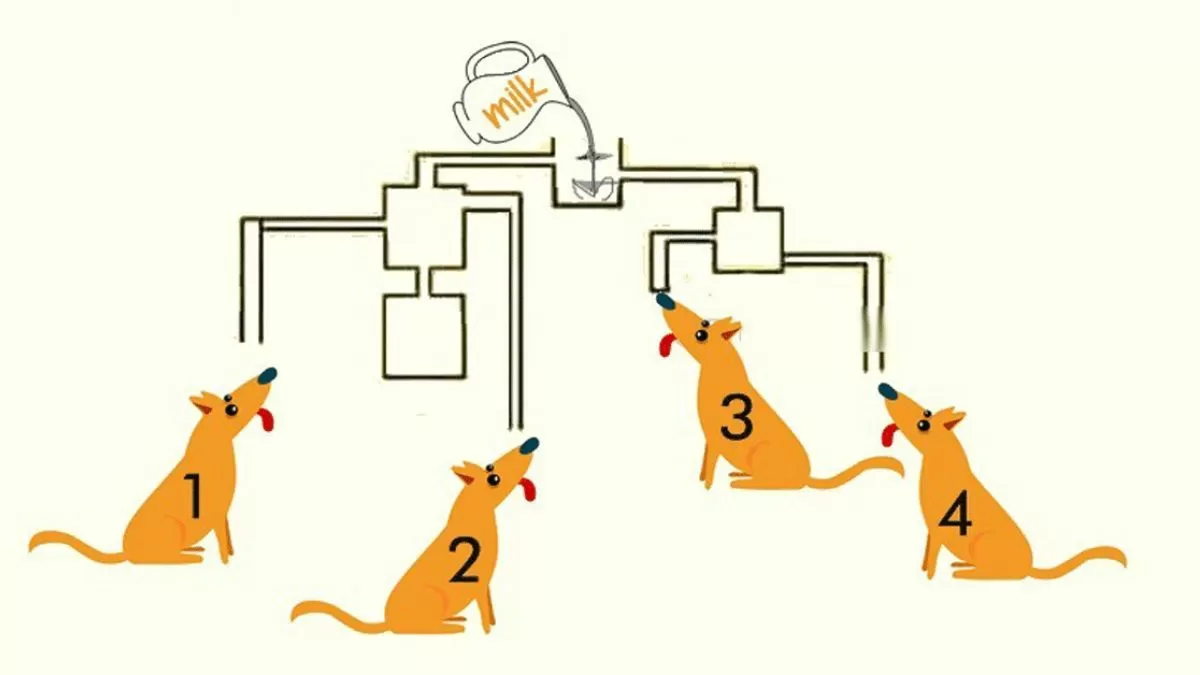This visual brain teaser has sparked plenty of debate and excitement online. The premise is simple yet deceptive: four eager dogs line up for their shot at a bowl of milk, but only one will get to drink it first. Can keen observers determine the correct answer within just eight seconds? At first sight, this might look like an ordinary logic puzzle, but a closer inspection reveals layers of complexity that challenge even experienced puzzle lovers.
The setup of the milk drinking order puzzle
Central to this riddle is an image featuring four playful dogs waiting beneath an elaborate pipeline system. Each dog appears linked to the jug of milk above by its own winding pipe. The task seems clear: identify which canine receives the milk first. However, as with the best brain teasers, things are never quite what they seem.
While every pathway starts off looking promising, hidden complexities lie along the routes. Only those equipped with sharp observation skills can spot the subtle clues embedded in the network. These details are essential for uncovering the true milk drinking order and cracking this clever challenge.
Dissecting the visual: where do the pipes lead?
Solving the puzzle means focusing on the sequence of each pipe. The maze-like structure may appear confusing at first glance, with twists and turns leading in all directions. Careful analysis uncovers the vital secret: not every pipe actually delivers milk to a dog’s bowl.
It is not simply about being quick; the real test lies in methodical reasoning. This is precisely what makes such logic puzzles so rewarding and engaging for those who enjoy mental challenges.
Identifying the blocked pipes
The element that sets this riddle apart is the presence of several cleverly blocked pipes hidden along the paths. A casual glance can easily overlook these obstructions, but they completely break the flow between the milk and most of the dogs.
For instance, while the pipes leading to dog number 1 and dog number 3 initially seem open, a closer look uncovers subtle blocks positioned at critical intersections. Dog number 4 faces a similar fate, with its pipeline discreetly cut off before any milk could reach its bowl.
The unobstructed route to dog number 2
After ruling out the other options, attention naturally shifts to dog number 2. Its pipeline stands out as the sole uninterrupted path—no hidden traps or sneaky blockages prevent the milk from flowing straight to this fortunate dog.
Examining the entire pipeline system quickly reveals that dog number 2 enjoys a clear advantage. The sequence of connections determines the outcome, making dog number 2 the indisputable solution to this logic puzzle.
Sharpening observation skills with visual riddles
Challenges like this go beyond pure entertainment—they provide excellent training for enhancing cognitive abilities and boosting observation skills. Many participants rush to answer, often missing crucial clues, which is exactly what these puzzles seek to counteract.
The thrill comes from the urgency: solving the riddle within eight seconds forces individuals to balance instinct with careful attention to overlooked details.
The psychology behind quick problem-solving
Fast-paced brain teasers put pressure on information processing skills. Visual riddles test how swiftly relevant cues are noticed amid distractions. Initially, most assume every dog has an equal chance since all appear connected by pipes.
However, only the truly observant catch inconsistencies almost immediately. Finding the solution within the tight time limit requires both sharp eyesight and rapid logical thinking—abilities that strengthen with regular practice.
Why most people get tricked by the first impression
This puzzle exploits the tendency to jump to conclusions after a superficial scan. Missing the blocked pipes leads to common mistakes and incorrect guesses.
Statistics show that fewer than one in four manage to pinpoint the correct answer within eight seconds. The challenge lies less in tracing the pipes than in resisting easy assumptions. Such brain teasers reward patience and thoroughness, providing lasting lessons for future logic-based problems.
How to approach pipeline-based puzzles
Tackling any pipeline riddle begins with discipline and a step-by-step approach. Focusing on which connections truly link the source and destination usually reveals the right answer.
A helpful strategy for similar challenges includes:
- Start at the milk source and identify all possible exits.
- Trace each pipe visually, watching carefully for any obstacles or dead ends.
- Compare routes at junctions, verifying whether the flow continues or is stopped.
- Rule out blocked pathways, narrowing down potential winners.
- Double-check every route before finalizing a choice to ensure no detail was missed.
Puzzles built around this type of pipeline structure often hinge on concealed obstacles. Reviewing all possibilities and cross-verifying increases the likelihood of success.
Building stronger logic through regular practice
Practicing with visual brain teasers that use blocked pipes or unusual sequences keeps mental faculties sharp. After mastering one version of a milk drinking order puzzle, it becomes easier to apply similar strategies to new formats. Repetition strengthens problem-solving habits, improving both speed and accuracy over time.
Regular engagement with such challenges fosters sharper intuition and better decision-making, benefiting not just games but real-life situations requiring close scrutiny and logical thought.
The true answer to the famous dog milk puzzle
Returning to the original question—within eight seconds, which dog gets the milk first—the answer is unequivocally dog number 2. Despite appearances, only this dog’s pipe remains free of hidden obstructions. All others are thwarted by cleverly placed blocks that stop the milk in its tracks.
This well-designed brain teaser tests both observation and deduction. Every attempt improves mental agility and proves that sometimes, the correct answer is found by looking past first impressions and trusting careful reasoning.








